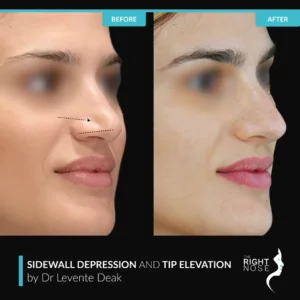Weekend recovery: What to expect after tip rhinoplasty surgery?
Weekend recovery: What to expect after tip rhinoplasty surgery?
Wondering if you can squeeze in a nose job and still make it to work on Monday? You might be surprised.
Tip rhinoplasty surgery, a specialised procedure that reshapes just the tip of the nose, is far less invasive than a full rhinoplasty—meaning quicker healing, less swelling, and minimal downtime. It’s a popular choice for those looking to make subtle, refined changes without the commitment of a long recovery.
In this blog, we’ll walk you through what to expect during a weekend of recovery—so you can plan smart, rest well, and get back to life looking and feeling your best.

What is a tip rhinoplasty surgery?
Tip rhinoplasty, also referred to as tip rhinoplasty or a mini nose job, focuses on reshaping the lower third of the nose by modifying the cartilage rather than the bone.
It’s an ideal option for those looking to refine a bulbous, drooping, or uneven nasal tip while preserving the overall shape of the nose.
Unlike full rhinoplasty, which involves changes to both bone and cartilage, tip rhinoplasty is a more targeted and less invasive procedure with a quicker recovery period.
Weekend recovery - What to expect?
Ethnic rhinoplasty might seem complex, but with the right surgeon, you can achieve excellent outcomes. Here are some approaches:
Day 1: The day of surgery
Most tip rhinoplasty procedures are performed under local anaesthesia with sedation, making them safe and relatively low-impact outpatient surgeries.
What to expect:
- Mild swelling or pressure around the nose tip.
- Taping or a small nasal splint to protect the new shape.
- Slight nasal congestion due to internal swelling.
- No sharp pain—just minor soreness or discomfort.
- Rest with your head elevated. Use a travel pillow to support your neck and reduce swelling.
Day 2: The first 24 hours post-op
Swelling may peak around this time, especially if you’ve had minor work on cartilage to correct a bulbous nasal tip.
What to expect:
- Swelling at the tip or under the eyes.
- Mild discomfort is managed easily with pain medication.
- Increased nasal congestion.
- Some drainage or crusting near the incision site.
Tip: Continue resting, follow your surgeon’s instructions on nasal care, and avoid blowing your nose. You may gently clean around the area with saline or as advised.
Day 3: Back on your feet
By the third day, most patients feel significantly better. The swelling begins to subside, and the discomfort is reduced.
What to expect:
- You can likely resume light activity.
- Swelling is still present, but manageable.
- You’ll start to see the early results of your new nose tip, though the final shape will take time.
This early stage is where patients start noticing the tip rhinoplasty before and after differences, even if subtle.
How long does tip rhinoplasty recovery take to heal?
While you’ll be functional within a weekend, full recovery from tip rhinoplasty can take a few weeks. The tip rhinoplasty recovery time is shorter than traditional rhinoplasty, but the nasal tip tends to retain swelling longer.
Here’s a general timeline:
- Day 7: You may still have tape on your nose. Most people can return to office work or regular routines.
- 1 Month: Swelling continues to reduce. The shape looks more refined.
- 3–6 Months: The final shape becomes more defined as any subtle swelling around the tip resolves.
Because the nasal tip tends to hold swelling longer than other areas, results continue to evolve over time. Still, you can enjoy a noticeably better shape even after one week.
How to have a smooth recovery after tip rhinoplasty surgery?
Here are some essential tips to ensure a smooth recovery after tip rhinoplasty surgery:
- Follow your surgeon’s instructions regarding medications and caring for the surgical site.
- Sleep with your head elevated—ideally with a travel pillow.
- Avoid rubbing, bumping, or blowing your nose.
- Don’t wear glasses that rest on the bridge of your nose for the first few weeks.
- Apply cold compresses around the cheeks—not on the nose.
- Skip workouts, heavy lifting, or bending for 3–4 weeks
Consult Dr Levente Deak for expert tip rhinoplasty surgery in Dubai
If you’re considering tip rhinoplasty, trust your care to Dr Levente Deak, a highly skilled Consultant ENT and Facial Plastic Surgeon in Dubai.
With over 15 years of outstanding experience, Dr Levente combines advanced surgical techniques with a personalised approach to deliver natural, refined results. Whether you’re seeking subtle refinement or correction of a bulbous nasal tip, he uses state-of-the-art techniques to deliver long-lasting and aesthetically pleasing outcomes.
Some Quick FAQs
Tip rhinoplasty focuses only on reshaping the nasal tip without altering the nasal bones or bridge. Rhinoplasty, however, addresses the entire nose structure—including the bridge, tip, and nostrils.
Bulbous tip rhinoplasty is a type of nasal surgery specifically aimed at refining a rounded or enlarged nasal tip. This can involve reshaping the cartilage to achieve a more defined and balanced appearance. It’s commonly sought by individuals who feel their nose tip is too wide or lacks definition.
Yes, most plastic surgeons or cosmetic clinics provide a gallery of before and after photos of bulbous tip rhinoplasty to help patients visualise potential outcomes. These images can help you understand what’s achievable and whether the procedure suits your aesthetic goals.
You can find tip rhinoplasty near me by searching for board-certified facial plastic surgeons or cosmetic surgery clinics in your area. Before making a decision, be sure to check patient reviews, before-and-after galleries, and surgeon qualifications.
Tip rhinoplasty is generally well tolerated and associated with minimal discomfort. Most patients report mild soreness or pressure rather than sharp pain. Swelling and tenderness may occur but are manageable with medication.





